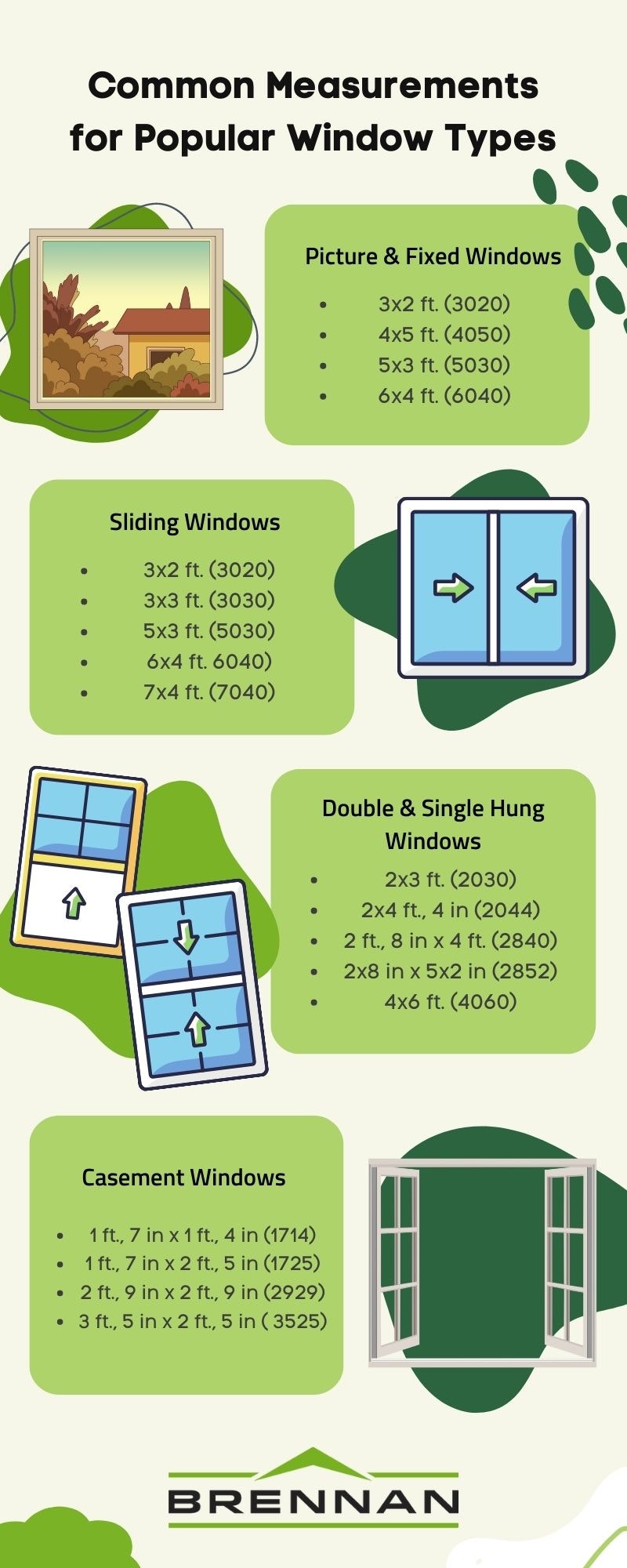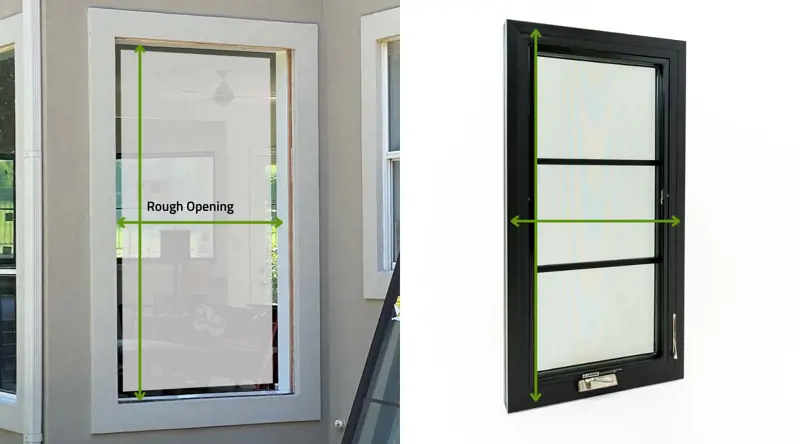
Standard Window Measurements Guide
Are you planning to buy new windows or replace your old windows? The first step is usually to get it right with your window sizes.
Standard sizes are available for windows used in new construction because these windows are installed and attached to the framed openings before any additional layers of building material are added.
Each window is ordered at a custom size for the replacement window to fit appropriately and get the best installation possible.
While there may not be "standard" window sizes for replacement windows there are common size approximations for window openings in Texas: 2x3; 2x4; 3x5; 3x6; 3x7; 3x8; 4x6; 4x7; 4x8.
But what are some of these standard window sizes? Here are some general window sizes for homes in Texas, but please note that sizes will typically vary since each home is its own unique project:
When measuring windows for replacement, you won't have access to the precise rough opening. So, to get the most accurate measurements, you’ll take measurements at multiple points of the existing window to get an approximate size of the rough opening. This works for replacement and is the reason why replacement windows are ordered with custom sizes.
Different window types have varied standard window measurements. We’ll go over the five major window types and their standard window dimensions.
First off, let's start with double-hung windows.
Standard double-hung window sizes
A double-hung has two movable window parts known as sashes. One at the top, the other at the bottom. In most cases, the top sash remains closed while the lower is raised to allow for some ventilation. Double-hung windows are longer vertically than horizontally.
Important to note: "Window measurements are always annotated in feet-inch format abbreviated as ft. /in. Therefore, read the measurements starting with the width followed by height sizes."
Let's look at this example of a 2x3 feet window. The normal window size will be:
2 feet, 0 inches by 3 feet, 0 inches correctly annotated as 2030. (Most windows will have a width between 24-48 ft. and heights between 36-72 ft.)
Now that you know the way the measurements are presented, it’s important to understand that replacement window sizings will be a little different. Each replacement window will have a custom size to ensure they will fit in the rough opening already available.
Here are normal windows sizes for double-hung windows you may find in North Texas:
- 2x3 ft. (2030)
- 2x4 ft., 4 in (2044)
- 2 ft., 8 in by 4 ft. (2840)
- 2x8 in by 5x2 in (2852)
- 4x6 ft. (4060)
You can also use these measurements for single-hung windows. The only difference with the double-hung windows is that the top sash does not move. However, the lower sash is mobile.
Next, let's look at the standard sizes of sliding windows.
Standard sliding window sizes
Sliding windows have two sashes that open and close horizontally. In some cases, either one or both sashes can move. Sliding windows are similar to hung windows because each of these styles technically slides but one slides vertically and the other horizontally.
Sliding windows tend to be longer in width than in height. A sliding window size is usually between 36-84 inches in width and between 24-60 inches in height.
Now that you have a general idea of what the standard window sizes are, we can get more specific. As you look for windows, it’s important to understand the difference between the rough opening and the actual size of a window.
A rough opening is the space on a wall that is cut out and designated for a window. The actual size is usually half an inch smaller than the rough opening size. Conversely, the actual size is usually half an inch smaller than the rough opening size.
Windows used for replacement aren't available in "standard" sizes, they are always custom. Common sliding window measurements you’ll see while window shopping are:
- 3x2 ft. (3020)
- 3x3 ft. (3030)
- 5x3 ft. (5030)
- 6x4 ft. 6040)
- 7x4 ft. (7040)
Another common window found in homes are picture windows – which are unopenable but great for providing unobstructed views:
Picture windows are the type of window meant to really showcase a view, they’re often used to frame gallery-like openings and as additions to complement operable windows.
Picture windows are generally thought of as simple in design and simple to manufacture, they can in fact be a great way to save costs on a project but the larger they are the more difficult they are to manufacture.
Making large sheets of glass without imperfections is challenging and building frames strong enough to support the weight of the glass (especially insulated and tempered glass) is also a challenge.
The normal window size for picture windows is between 24-96 inches for widths and 12-96 inches for heights.
Windows used for replacement aren't available in "standard" sizes, they are always custom. Here are some common window sizes for picture windows you’ll likely see on the market:
- 3x2 ft. (3020)
- 4x5 ft. (4050)
- 5x3 ft. (5030)
- 6x4 ft. (6040)
Casement windows open more like traditional hinged doors except they are fixed to the frame and they open in a controlled manner.
Casement windows may have one or more sashes depending on the design. Their main purpose is to keep your house ventilated.
Casement windows are common in bathrooms and kitchens. They are increasingly popular in more common areas of the home, especially living rooms.
Common casement window dimensions range between 17-41 inches in height and 16-33 inches in width. Replacement windows are almost always custom sizes. However, there are some common window sizes.
Some dimension combinations for casement standard-size windows include:
- 1 ft., 7 in by 1 ft., 4 in (1714)
- 1 ft., 7 in by 2 ft., 5 in (1725)
- 2 ft., 9 in by 2 ft., 9 in (2929)
- 3 ft., 5 in by 2 ft., 5 in ( 3525)
Bay windows add beauty and architectural enhancements to your house and can make your rooms feel more spacious.
Common bay window sizes are as follows:
- Widths between 3 ft., 6 in, and 10 ft., 6 in
- Heights between 3-6 feet, 6 in
Expected bay window size combinations include:
- 3 ft., 6 in by 3 feet (3630)
- 3 ft., 6 in by 6 feet, 6 inches (3666)
1. Are window sizes standardized?
No, window sizes are not standardized. However, you may find some common window size ranges on the market depending on your window manufacturer and the window spaces designated for your home. These are typically just the most common window sizes in Texas homes.
2. What window sizes are standard
Standard window sizes will depend on the type of window you choose for your home. However, most windows will have sizes between 24 and 48 inches.
3. Where is the information on the window size found?
Check for markings on the surfaces of your window. You can typically find the information about your window size and warranty in between the panels. It should look like this:
4. Can you change the size of a window opening?
Yes, you can change the size of your current window opening to allow for a bigger or smaller window to be installed instead.
Final thoughts
Generally, windows for new construction applications can be larger in size because they are being installed before any additional building materials go on the home.
On the other hand, to help keep replacement window installations affordable, we do everything we can to keep the additional building materials unbothered. Because of this, the replacement window frame is often smaller than the original window but it also means the window should go into the opening easily.
You have to be careful with ordering the right size window so that you avoid having too much space between the window frame and the opening. The window should sit just right.
If you have a lot of space it means you'll need more material to get it to sit right including shims and insulation, it also results in more air getting in through the space in the wall.
Oops!
We don't currently serve your area but do want to help you plan your project. Try our Build & Price tool to get an idea of window & door costs within DFW. Your area may be higher or lower but at least you'll have some idea of the price.
Thanks for stopping by.








